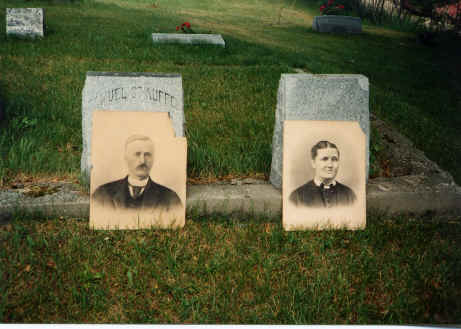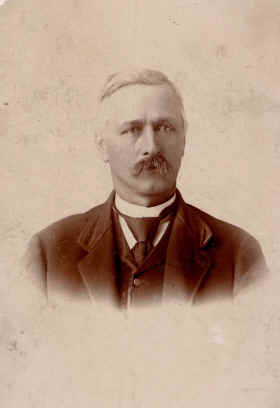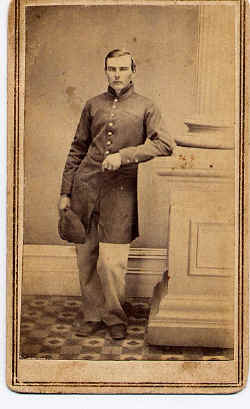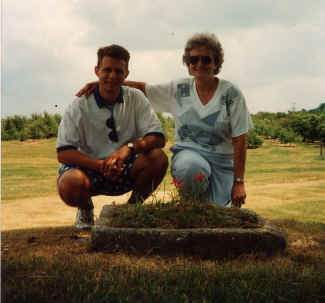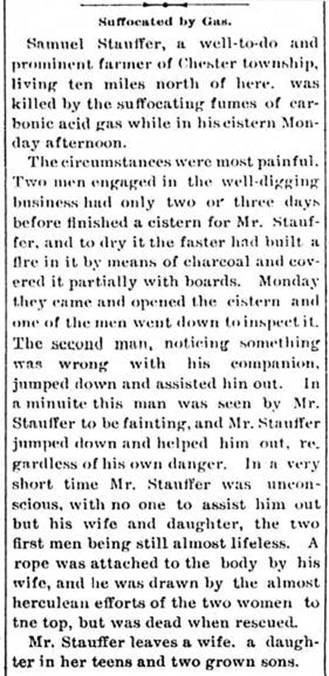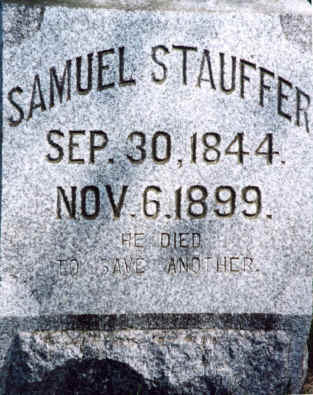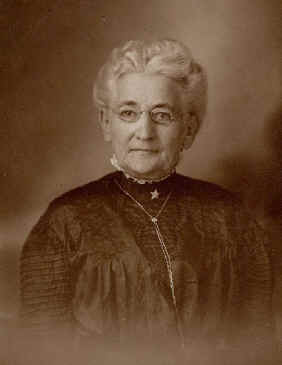|
SAMUEL STAUFFER and ROXANA WELLS |
|||||||||||||||
|
(1844-1899) |
(1843-1909) |
||||||||||||||
Samuel Stauffer was born to a thirty-year-old father who, in the previous nine years, had married, watched five children born an four of them
dye very early, and finally watched his young wife die a horrible death from rabies
(a fifth child, a newborn, lived). Within a year, Abraham had remarried (see Abraham and
Magdalena), and Samuel was born to them. Following George, three other sons were born into the family—Moses, Noah, and Aaron. We knew early on that Moses and Aaron had died as infants, all this by the time Samuel was seven. We had seen Noah’s grave near other family in the Bennett Cemetery outside Grand Rapids, but not until 2004 did we learn of his close connection to the family. Read about that discovery and his brief life in Two Stauffer Mysteries. When Samuel was ten, George was eight, and little Noah was just three, Abraham decided to join some of his siblings and move his family to Michigan (Migration: A Family Affair). Despite the fact that some aunts, uncles, and cousins had already made the move, it must have been difficult to part from the remaining members of the extensive Stauffer family, perhaps never to see them again. We don't know how they made the trip--perhaps, by 1854 it could be made by train rather than covered wagon as those two earlier generations had made the trip to Ontario. We can imagine the excitement the young brothers likely experienced in anticipation of the move to “new frontiers.” We now have reason to believe that their mother, Magdalena, was pregnant during the journey and that one more baby brother was born in September after their arrival, only to die thirteen days later.
ROXY Roxy was the third of four daughters. Her sister Marcia was four when she was born and Marion almost two. Roxy was the baby of the family until she was nearly five, at which time baby sister Mary Jane arrived. In 1854 when Roxy was 11 (the same year the Stauffer family left Ontario), the Wells family set out from Painted Post, New York, also for Michigan. The Stauffers didn't move to Chester Township, Ottawa County, however, until 1862; they were in the Caledonia area for eight years before that. In August of 1860, two
months before her 17th birthday and Abraham Lincoln’s election as president,
Roxy was certified to teach in the schools of Ravenna, Michigan. The document,
handwritten on yellow lined paper, reads as follows: It is hereby certified that Roxana Wells has passed a satisfactory examination in the following branches, that is: Reading, Writing, Spelling, Geography, Grammar, Arithmetic, and has moreover been found to be of a good moral character and we do hereby licensed her to teach in the primary schools of this township for one year. Given under our hands this 27th day of August, A.D. 1860. Signed, Davie T. Stafford, Inspector
Scanned
Image of Roxy's Teaching Certificate Roxy did not marry until
five years later, six months after the assassination of Abraham Lincoln. Was
she teaching school through the years of the Civil War? Perhaps, but no
other one-year certificates have survived. What did survive is a picture of one
of her cousins, Silas Compton, who fought in the Civil War. A picture of him in
his uniform was among the things found in the Bible. Thanks to the Internet, we
were in touch with one of Silas's descendants, and we thought she should have the
original picture. (Five years after the war, Silas was killed in a terrible accident, crushed to death
working on the Erie Canal.) THE BIBLE AND THE WEDDING To Samuel and Roxy were
born four children over 14 years.
We don’t have many clues
to events in Samuel and Roxy’s life during the years they were raising their
children. In March of 1887, Roxy’s parents celebrated their fiftieth
anniversary. Hannah was apparently not well in her last years. A letter
survives in the family written to Roxy by her father telling of her mother’s
ill health and saying how much he wished his daughter could come. A month
following the writing of the letter, Hannah died
on April 28, 1888, at age 67. Three
months later, in July, her granddaughter Rose Stauffer died of consumption (tuberculosis).
She was George and Jane’s 18-year-old daughter and cousin of Samuel and Roxy’s
children. TRAUMA The brick farmhouse on 16th Street outside of Sparta was built late in the last decade of the 19th Century, and we believe the Stauffers were the first to live in it. It was there on November 6, 1899, not far from the back door and just seven weeks before the turn of the century, that Samuel died swiftly and unexpectedly in a tragic accident. He was 55 years old, and they had just marked their 34th wedding anniversary. The inscription of his headstone reads, “He died to save another.” As I was growing up, we heard often about Grandfather Stauffer's death, how he "succumbed to fumes" and "died in a well" trying to save another man's life. When I wrote the imaginary letter to him on the anniversary of his death after visiting the site, I had more questions than answers. Since then we have learned much more. (For a complete account of what happened, see " Note" following "Letter to Samuel Stauffer.") The most dramatic thing we have recently learned is that Roxy was not only present, but when her husband collapsed, she somehow attached a rope to his body and "he was drawn by the almost Herculean efforts of the two women to the top" (see obit to right), the second woman being daughter Mabel. It is unclear whether Roxy herself went into the well. But it was too late for Samuel. It is a scene painful to imagine.
TRIBUTES
Her last words to her family gathered around her were: “We have been so happy together. You were all so good to me. I am so glad to go. Meet me over there.” The obituary closes: “To us it is a loss never to be replaced, to her it is a gain for all eternity.” Her funeral was conducted by Rev. I.B. Buffum, undoubtedly in the North Chester Baptist Church, north on 16th Street within site of the farmhouse. |
|||||||||||||||
